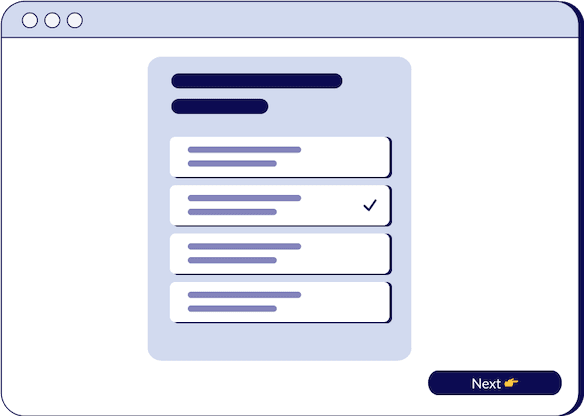
How to Read Other People's Social Style
John Walsh
Owner of Breakthrough

- duration
- 12 min
- Average Score
- 81%
- Stars
- 5
In the dynamic world of sales, understanding the nuances of social styles is a valuable tool for sales reps. This knowledge allows them to communicate effectively, build rapport, and create more successful interactions with customers. In this guide, we'll delve into the basics of social styles and explain how recognizing and adapting to them can significantly enhance your sales performance.
The Foundation of Social Styles
Social styles are built on the universal truth that we tend to respond better to individuals who share similar traits and behaviors. These styles stem from the research of psychologists Bolton and Bolton, who identified two fundamental aspects of personality:
- Assertiveness: This measures one's ability to express their views and opinions without harming others. It determines the extent to which an individual is comfortable sharing their perspective.
- Expressiveness: Expressiveness relates to how much one conveys their thoughts and emotions through facial expressions, body language, tone of voice, and communication style.
When you combine assertiveness and expressiveness, you'll find that individuals tend to fall into four distinct quadrants, each representing dominant personality preferences. These preferences influence how we interact with others and can be observed through body language, tone of voice, and behavior.
Understanding the Quadrants
Driver - The Decisive Achiever
Traits:
- High assertiveness (expresses views clearly).
- Low expressiveness (limited facial expressions and modulation in voice).
- Direct and to the point.
- Minimal body language and gestures.
Behavior: Drivers are focused on results and efficiency. They value productivity, prefer short, direct communication, and are often seen as decisive and assertive.
Expressive - The Enthusiastic Influencer
Traits:
- High assertiveness (freely expresses views).
- High expressiveness (animated facial expressions and expressive tone of voice).
- Fast talkers and movers.
- Engaging body language with a desire to be the center of attention.
Behavior: Expressives are enthusiastic and persuasive. They enjoy talking and sharing their experiences. They are often seen as lively, engaging, and enthusiastic communicators.
Amiable - The Supportive Harmonizer
Traits:
- Low assertiveness (reluctant to voice opinions).
- High expressiveness (expressive facial expressions and tone of voice).
- Softer tone of voice and gestures.
- Friendly and approachable posture.
Behavior: Amiable individuals prioritize harmony and seek to build strong relationships. They focus on the well-being of the team and value a friendly, non-confrontational communication style.
Analytical - The Logical Thinker
Traits:
- Low assertiveness (reluctant to voice opinions).
- Low expressiveness (minimal facial expressions and monotone voice).
- Slower pace of communication.
- Analytical and detail-oriented.
Behavior: Analytical individuals are methodical and prefer a systematic approach. They are keen on detail and often take their time to think things through before making decisions.
Why Recognize and Adapt to Social Styles?
Adapting your communication style to different social styles is a strategic move that can greatly enhance your effectiveness as a sales rep. By recognizing and understanding where an individual falls on the social style spectrum, you can:
- Build Rapport: When you communicate in a way that aligns with the customer's social style, you establish rapport more quickly and effectively.
- Enhance Communication: Tailoring your communication to the customer's style leads to better understanding and engagement.
- Achieve Better Outcomes: By adapting your approach, you are more likely to reach desired outcomes and create a positive customer experience.
- Improve Relationships: Your ability to connect on a personal level with customers can lead to long-term relationships and repeat business.
Taking Action
To effectively recognize and adapt to different social styles, you need to observe the customer's body language, tone of voice, and communication style. Ask yourself two fundamental questions:
- Is the person more assertive or less assertive? This helps you determine whether they are more focused on expressing their views or more reserved in sharing their opinions.
- Is the person more task-oriented (asking) or people-oriented (telling)? This helps you identify if they are more focused on the task at hand or on building relationships with others.
By answering these questions, you can place the individual in one of the four quadrants and tailor your communication to align with their social style. The more you can flex your style to meet theirs, the more successful your interactions are likely to be.
For a deeper understanding and practical examples of adapting to social styles in sales, watch this session. It provides valuable insights into putting this knowledge into action, helping you achieve more effective and rewarding customer interactions.
In summary, mastering social styles is a powerful tool for sales reps. By recognizing and adapting to the unique preferences of each customer, you can create a stronger connection, enhance your communication, and drive better outcomes. Switch on your social style sensor, and watch your sales success soar.
How Triple Session works
Training, Testing, & Feedback
Triple Session's proven formula accelerates your sales performance through consistent, organized practice, backed by measurable results.

Bite-Sized Knowledge
Our expert-led video sessions simplify complex sales concepts into easy-to-digest 5-15 minute videos for better retention.

Test Your Understanding
After each session, there will be a quiz to test your understanding and help you improve on any areas that need more attention.

Evaluate and Grow
Get progress snapshots after each quiz to track your improvements and achieve your sales mastery goals.